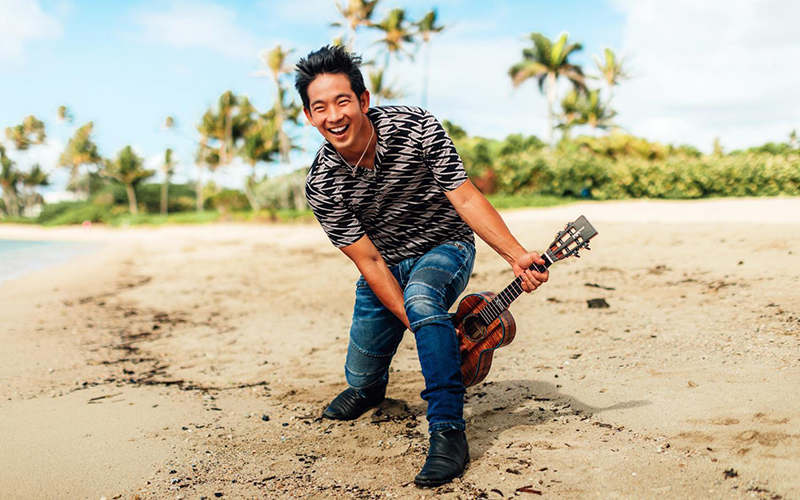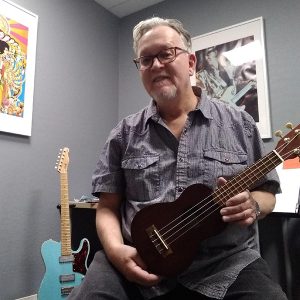
Ukulele artist Jake Shimabukuro. (Photo courtesy of Sienna Morales)
PHOENIX – What has four strings and starts with “u”?
You probably know the answer but maybe not the history behind the ukulele. Its sound is distinctive, but the pronunciation of the name varies.
“I think the most common pronunciation is ‘you-kih-LAY-lee,’ like ‘y o u,’ but it’s actually ‘ook-ih-LAY-lee,’” said Rich Walter, curator for the U.S., Canada and Europe at the Musical Instrument Museum in Phoenix.
He said the ukulele is associated with Polynesian and other Pacific Islander cultures because of Portuguese influence that arrived in the Hawaiian Islands in the 19th century.
“Originally, a very similar instrument did come directly from Portugal and the Madeira Islands,” Walter said. “It was a variation of something called a cavaquinho or burgeenya.”
Although it may not be thought of by some players as a serious instrument, the “ook,” as it’s often called, it certainly is for most professional musicians and for the fans who love its sound.
“Since it was renamed and kind of re-embraced in Hawaii around 1879, 1880s, there’s a real tradition of it being an incredibly serious and even kind of royal instrument,” Walter said.

Musical Instrument Museum in Phoenix. (Photo courtesy of David Lofink)
Scotty Spenner, a longtime musician and music teacher in the Valley, said most people who play other stringed instruments and sing often just strum chords to accompany their voice. But the ukulele offers unique tuning and complex sonic options its sibling instruments do not.
“Because of that unusual tuning on the fourth string being tuned an octave higher than you would find on most stringed instruments like a violin, guitar or mandolin, it creates a situation where you can really have notes ring against each other like a harp more than most stringed instruments,” he said.
Spenner plays a variety of music and has taught for 40 years. For some of that time, he has focused on guitar, mandolin and ukulele for aspiring players at Strum University, which offers professional lessons in north Phoenix.
Practicality is one of the reasons Spenner encourages the ukulele versus the guitar for some younger students.
“When I get kids that are younger than 9 that just aren’t physically big enough to play a guitar, I’ll usually steer them to ukulele because the tuning is very similar,” he said. “If they go on to play guitar they’ll be able to use the same chord shapes.”
(Spenner, by the way, said he pronounces it “you-kih-LAY-lee” because he’s from North Carolina and retains the region’s characteristic drawl.)
Jake Shimabukuro is a ukulele phenom whose unique style has electrified audiences worldwide and inspired many to pick up the instrument. More than a decade ago, Shimabukuro made the Beatles’ “While My Guitar Gently Weeps” famous again, and his other covers include “Bohemian Rhapsody” by Queen.
Shimabukuro is a native Hawaiian who was 4 when his mother taught him the ook.

Musician Scotty Spenner. (Photo courtesy of Scotty Spenner)
“She was the one who first introduced me to the instrument. She sat me down and taught me just a couple of chords and I just fell in love with it.”
He said one reason he adores the ukulele is it can be played straight away. In an interview before his performance Friday at Scottsdale Center for the Performing Arts, Shimabukuro laughed when asked how he pronounces the name of what some refer to as a miniature guitar.
“In Hawaii, we say ‘ook-eh-LEH-lay.’ It’s two Hawaiian words: ‘uku’ and ‘lele,’ which actually means ‘jumping flea.’ It’s one of the only string instruments aside from, like, a strumstick where you can play full chords with just one finger. It doesn’t require a lot of left-hand or finger strength.”
Shimabukuro is touring in support of his new release, “Jake and Friends,” whose list of collaborators includes Willie Nelson, Bette Midler, Jimmy Buffett, Michael McDonald, Vince Gill, Amy Grant and Moon Taxi. Proof of vaccination is required to attend, and all patrons must wear masks.
Shimabukuro said he was humbled to collaborate with those iconic musicians but acknowledged he didn’t think the album would ever come to fruition.
“It was such an honor. When I first started talking about this project with my manager, I thought, ‘It’s a great idea.’ But in the back of my head, I was saying, ‘This is never going to happen.’
“I mean, it was such a far out idea and I just think all of these artists who I love, admire and respect wouldn’t really take the time and do a song with me on this project.”
He capped his comments with a characteristic salutation: “Mahalo. Take care. Aloha.”